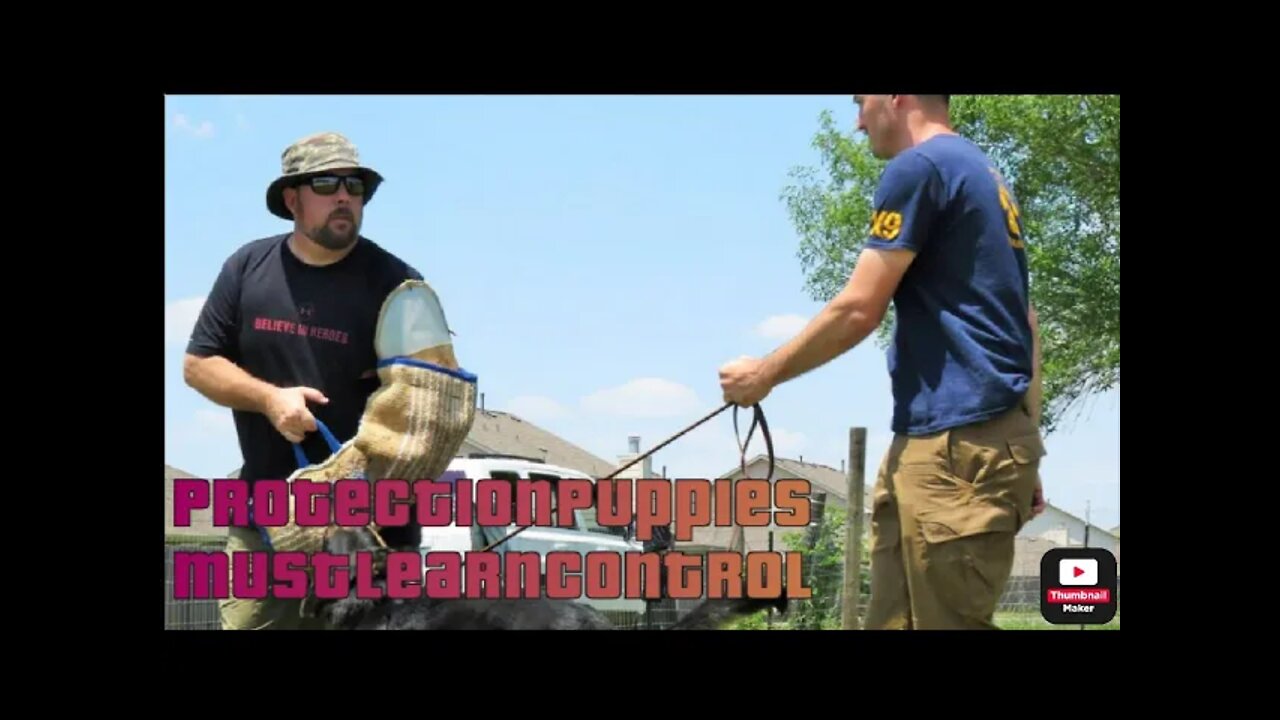Premium Only Content

Protection Puppies Control
Five Tips for Training Your Dog to Protect You
If you are sure that you want a personal protection dog—and not a pet—what do you need to do? Here are five tips for training a dog to protect you.
1. Teach Your Dog Obedience Commands
The first thing you need to do is teach your dog basic obedience: Your dog must respond to all basic obedience commands. He should sit, lie down, and come to you 100% of the time when called. Your dog should heel without a leash. In addition, your dog should learn and respond to the “bark” and “leave it” commands.
Important note: If your dog does not follow these commands consistently, or if you are not able to teach her new commands, you need to stop trying to turn your pet into a personal protection dog.
2. Socialize Your Dog
You also need to socialize your dog so that she does not fear new and unusual situations. This is best done during the sensitive socialization period (up to about 16 weeks) but of course, this is not possible for all dogs.
Socialization can take place every time you take your dog for a walk. If you see a strange object, especially if the dog is nervous, take her closer so that she can investigate. Your dog also needs to recognize what a normal pedestrian looks like and not feel threatened, or feel that he needs to threaten, any other person he happens to meet.
Important Note: Not every dog is able to distinguish who is safe—and so of course not every dog should be trained for personal protection.
3. Teach Your Dog to Bark on Command
Encourage your dog to bark at the approach of any stranger. (If you need more help with this, here are my tips for training your dog to bark on command.) A dog that barks at a stranger can be more effective than a dog that responds to an “attack” command but does not bark.
Some dogs are not good at learning this command. I have a Pit Bull that I trained to bark at the word "urubu" (vulture) since she gets excited and barks at them on the beach. Now, when I want her to bark, I just say the word urubu.
Take note of what your dog does naturally and sometimes he will respond.
Barking comes naturally to many dogs, but you may need to teach your dog to stop barking when given a command. When he has barked once or twice, you can tell him to sit and then order him to stop. If he does not stop, order the dog “down.” It is very difficult for a dog to bark when he is on the ground.
Important Note: If your dog will not bark on command and does not even bark at strangers, he is not a good choice for a protection dog.
4. Teach Your Dog to Defend You
For the next step in the training process, you need to find someone the dog does not know. The “stranger” approaches during the walk, walks up and challenges your dog. He can be wearing a dog attack suit, an oven mitt, or even a quilted blanket on his arm, but he may not even need it. When you give the command and your dog barks at him, he needs to act afraid and run off. Your dog will become more confident.
Personally, I think this is a good place to stop. Your dog has already learned to bark and appear threatening to anyone that threatens you when out walking.
Think Long and Hard Before Training Your Dog to Attack
If you decide to go further, please realize that a dog that has been trained to attack is not a great pet to have around the house. There are many anecdotes about docile family attack dogs and there are also many anecdotes of attack dogs that have injured someone in their household (usually one of the children). There is also the possibility that your dog might bite someone who is just coming up to talk to you; you can be sued and might lose everything you have because your dog is a trained attack animal.
The next time a different "stranger" approaches your dog and makes threatening gestures he will probably start barking even before you give him a command; if you want to proceed you should loosen (but not release) your dog's leash.
You can then allow him to go up and grab the stranger's protected arm. (You may need to encourage him by telling him "get him" in an excited voice, but some dogs will go ahead and approach the stranger alone.) If your dog does not approach the stranger, that person should put his padded arm close to the dog, threaten the dog, and encourage him to bite.
Important Note: If the dog cowers or shows fear of the stranger, he is not suitable as a personal protection dog.
5. Teach Your Dog to Back Off
This is really one of the most important parts of training a personal protection dog. He must be willing to protect you but he must always be willing to leave the person alone.
For example, if you choose to train your dog to attack (which again, I do not recommend), as soon as your dog puts his teeth on the "stranger" in the scenario above, he should be told “leave it” and given praise.
#dogs #pets #petslover #animals #animallovers #touchpad #dogtraining #puppies #adultdogs
-
 8:10:03
8:10:03
Dr Disrespect
19 hours ago🔴LIVE - DR DISRESPECT - WARZONE - HUNTING SEASON
263K77 -
 1:32:28
1:32:28
Fresh and Fit
12 hours agoHow To Wholesale and Fix & Flip Real Estate!
75.7K11 -
 1:30:55
1:30:55
Flyover Conservatives
1 day agoDrones, Darkness, and Divine Intervention: Unpacking Prophecy and Reality - Dr. Troy Spurrill | FOC Show
47.6K3 -
 59:32
59:32
The StoneZONE with Roger Stone
10 hours agoHonoring Great American Patriots for Helping to Save our Country | The StoneZONE w/ Roger Stone
98.1K8 -
 1:09:50
1:09:50
Donald Trump Jr.
15 hours agoHow Sean Parnell Helped Deliver PA, Plus Why Pete Hegseth Must Be Confirmed | TRIGGERED Ep.199
221K95 -
 1:58:03
1:58:03
Tucker Carlson
13 hours agoJeffrey Sachs: The Inevitable War With Iran, and Biden’s Attempts to Sabotage Trump
224K394 -
 1:31:00
1:31:00
Redacted News
15 hours agoBREAKING! Trump demands answers on UFOs over America as Pentagon hides the truth | Redacted News
214K370 -
 1:07:45
1:07:45
BIG NEM
13 hours agoSpiritual STDs, Nikola Tesla & Harnessing Creative Energy! ⚡💡
39.6K2 -
 38:09
38:09
Patriots With Grit
12 hours agoWe Must Finish This Fight | Glenn Baker
30.8K -
 54:52
54:52
LFA TV
1 day agoWhy Did God Bring Donald Trump Back to the White House? | Trumpet Daily 12.16.24 7PM EST
46.8K9